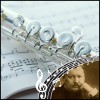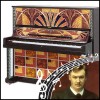Composers
Glazunov Aleksandr Konstantinovich
| Country: | Russia |
| Period: | Classique |
Prodigy
Glazunov was born in Saint Petersburg, the son of a wealthy publisher (his father had published Alexander Pushkin's Eugene Onegin). He began studying piano at age of nine and began composing at 11. Mily Balakirev, former leader of the nationalist group "The Five", recognized Glazunov's talent and brought his work to the attention of Nikolai Rimsky-Korsakov. "Casually Balakirev once brought me the composition of a fourteen- or fifteen-year-old high-school student, Sasha Glazunov", Rimsky-Korsakov remembered. "It was an orchestral score written in childish fashion. The boy's talent was indubitably clear." Balakirev introduced him to Rimsky-Korsakov shortly afterwards, in December 1879. Rimsky-Korsakov premiered this work in 1882, when Glazunov was 16. Borodin and Stasov, among others, lavishly praised both the work and its composer.
Rimsky-Korsakov taught Glazunov as a private student. "His musical development progressed not by the day, but literally by the hour", Rimsky-Korsakov wrote. The nature of their relationship also changed. By the spring of 1881, Rimsky-Korsakov considered Glazunov more of a junior colleague than a student. While part of this development may have been from Rimsky-Korsakov's need to find a spiritual replacement for Modest Mussorgsky, who had died that March, it may have also been from observing his progress on the first of Glazunov's eight symphonies.
Mentored by Belyayev
More important than this praise was that among the work's admirers was a wealthy timber merchant and amateur musician, Mitrofan Belyayev. Belayev was introduced to Glazunov's music by Anatoly Lyadov and would take a keen interest in the teenager's musical future, then extend that interest to an entire group of nationalist composers. Belayev took Glazunov on a trip to Western Europe in 1884. Glazunov met Liszt in Weimar, where Glazunov's First Symphony was performed.
Also in 1884, Belayev rented out a hall and hired an orchestra to play Glazunov's First Symphony plus an orchestral suite Glazunov had just composed. Buoyed by the success of the rehearsal, Belayev decided the following season to give a public concert of works by Glazunov and other composers. This project grew into the Russian Symphony Concerts, which were inaugurated during the 1886–1887 season.
In 1885 Belyayev started his own publishing house in Leipzig, Germany, initially publishing music by Glazunov, Anatoly Lyadov Rimsky-Korsakov and Alexander Borodin at his own expense. Young composers started appealing for his help. To help select from their offerings, Belayev asked Glazunov to serve with Rimsky-Korsakov and Lyadov on an advisory council. The group of composers that formed eventually became known at the Belayev Circle.
Fame
Glazunov soon enjoyed international acclaim. Nevertheless, he experienced a creative crisis in 1890–1891. He came out of this period with a new maturity. During the 1890s he wrote three symphonies, two string quartets and the ballet Raymonda. By the time he was elected director of the Saint Petersburg Conservatory in 1905, he was at the height of his creative powers. His best works from this period are considered his Eighth Symphony and Violin Concerto. This was also the time of his greatest international acclaim. He conducted the last of the Russian Historical Concerts in Paris on 17 May 1907 and received honorary Doctor of Music degrees from the universities of Oxford and Cambridge. There were also cycles of all-Glazunov concerts in Saint Petersburg and Moscow to celebrate his 25th anniversary as a composer.
Conductor
Glazunov made his conducting debut in 1888. The following year, he conducted his Second Symphony in Paris at the World Exhibition.. He was appointed conductor for the Russian Symphony Concerts in 1896. In March of that year he conducted the posthumous premiere of Tchaikovsky's student overture The Storm. In 1897, he led the disastrous premiere of Rachmaninoff's Symphony No 1. The composer's wife later claimed that Glazunov seemed to be drunk at the time. While this assertion cannot be confirmed, it is not implausible for a man who, according to Shostakovich, kept a bottle of alcohol hidden behind his desk and sipped it through a tube during lessons.
Drunk or not, Glazunov had insufficient rehearsal time with the symphony and, while he loved the art of conducting, he never fully mastered it. From time to time he conducted his own compositions, especially the ballet Raymonda, even though he may have known he had no talent for it. He would sometimes joke, "You can criticize my compositions, but you can't deny that I am a good conductor and a remarkable conservatory Director."
Despite the hardships he suffered during World War I and the ensuing civil war, Glazunov remained active as a conductor. He conducted concerts in factories, clubs and Red Army posts. He played a prominent part in the Russian observation in 1927 of the centenary of Beethoven's death, as both speaker and conductor. After he left Russia, he conducted an evening of his works in Paris in 1928. This was followed by engagements in Portugal, Spain, France, England, Czechoslovakia, Poland, the Netherlands, and the United States.
Conservatory
In 1899, Glazunov became a professor at the Saint Petersburg Conservatory. In the wake of the 1905 Russian Revolution and firing, then re-hiring of Rimsky-Korsakov that year, Glazunov became its director. He remained so until the revolutionary events of 1917, which culminated on 7 November. His Piano Concerto No. 2 in B minor, Op. 100, which he conducted, was premiered at the first concert held in Petrograd after that date. After the end of World War I, he was instrumental in the reorganization of the Conservatory—this may, in fact, have been the main reason he waited so long to go into exile. During his tenure he worked tirelessly to improve the curriculum, raise the standards for students and staff, as well as defend the institute's dignity and autonomy. Among his achievements were an opera studio and a students' philharmonic orchestra.
Glazunov showed paternal concern for the welfare of needy students, such as Dmitri Shostakovich and Nathan Milstein. He also personally examined hundreds of students at the end of each academic year, writing brief comments on each. Unfortunately, according to Shostakovich's comments in Testimony, Glazunov's alcoholism may have progressed to the point that he could not give a lesson while sober. Glazunov taught only chamber music by the time Shostakovich was a student. Glazunov sat at his desk, not interrupting the music being played during class. He spoke quietly and briefly, his comments becoming less distinct and briefer toward the end of the lesson.
While Glazunov's sobriety could be questioned, his prestige was not. Because of his reputation, the Conservatory received special status among institutions of higher learning in the aftermath of the October Revolution. Glazunov established a sound working relationship with the Bolshevik regime, especially with Anatoly Lunacharsky, the minister of education. Nevertheless, Glazunov's conservatism was attacked within the Conservatory. Increasingly, professors demanded more progressive methods, and students wanted greater rights. Glazunov saw these demands as both destructive and unjust. Tired of the Conservatory, he took advantage of the opportunity to go abroad in 1928 for the Schubert centenary celebrations in Vienna. He did not return. Maximilian Steinberg ran the Conservatory in his absence until Glazunov finally resigned in 1930.
Exile
Glazunov toured Europe and the United States, and settled in Paris. He always claimed that the reason for his continued absence from Russia was "ill health"; this enabled him to remain a respected composer in the Soviet Union, unlike Stravinsky and Rachmaninoff, who had left for other reasons. In 1929, he conducted an orchestra of Parisian musicians in the first complete electrical recording of The Seasons. In 1934 he wrote his Saxophone Concerto. He died in Paris at the age of 70. The announcement of his death shocked many. They had long associated Glazunov with the music of the past rather than of the present, so they thought he had already been dead for many years.
In 1972 his remains were reinterred in Leningrad.
Married life
In 1929, at age 64, he married the 54-year-old Olga Nikolayevna Gavrilova (1875-1968). The previous year, Olga's daughter Elena Gavrilova had been the soloist in the first Paris performance of his Piano Concerto No. 2 in B major, Op. 100. He subsequently adopted Elena (she is sometimes referred to as his stepdaughter), and she then used the name Elena Glazunova. In 1928, Elena had married the pianist Sergei Tarnowsky, who managed Glazunov's professional and business affairs in Paris, such as negotiating his United States appearances with Sol Hurok. Elena later appeared as Elena Gunther-Glazunova after her second marriage, to Herbert Gunther (1906-1978).
Works and influence
Phenomenal memory
Glazunov was acknowledged as a great prodigy in his field and, with the help of his mentor and friend Rimsky-Korsakov, finished some of Alexander Borodin's great works, the most famous being the Third Symphony and the opera Prince Igor, including the popular Polovetsian Dances. He reconstructed the overture from memory, having heard it played on the piano only once. Shostakovich reports, however, that Glazunov told him when drunk that his "reconstruction" of Borodin's overture was actually original work; Glazunov chose to give full credit to Borodin for the composition which he, Glazunov, wrote. Glazunov's ability to perfectly mimic Borodin's style is a tribute to his musical creativity. His giving the credit to Borodin, Shostakovich felt, said much for Glazunov's character. "It doesn't happen often that a man composes excellent music for another composer and doesn't advertise it (to talk while drinking doesn't count). It's usually the other way around—a man steals an idea or even a considerable piece of music and passes it off as his own."
Shostakovich mentioned in Testimony that there were many similar stories about Glazunov's memory. One of the more famous ones, he recalled, was when Sergei Taneyev came to Saint Petersburg with a new symphony. The person whom Taneyev was visiting hid the teenage Glazunov in the next room. Taneyev played his symphony on the piano for the host. The other guests praised and congratulated him. The host then told Taneyev, "I'd like you to meet a talented young man. He's also written a symphony." He brought Glazunov in from the next room. The host said, "Sasha, show your symphony to our dear guest." Glazunov sat down at the piano and played Taneyev's symphony from beginning to end, after hearing it only once and through a closed door.
Age did not weaken Glazunov's memory. Another story Shostakovich relayed was of an "eternal student" applying to enter the composition department at the Saint Petersburg Conservatory. The applicant played a piano sonata he had written. Glazunov listened. When the applicant had finished, Glazunov said, "If I'm not mistaken, you applied a few years ago. Then, in another sonata, you had quite a good secondary theme." Glazunov sat down at the keyboard and played a large segment of the old sonata. "The secondary theme was rubbish, of course", Shostakovich said, "but the effect was enormous."
Compositions
Glazunov's most popular works nowadays are his ballets The Seasons and Raymonda, some of his later symphonies, particularly the Fourth, Fifth and Sixth, and his two Concert Waltzes. His Violin Concerto, which was a favorite vehicle for Jascha Heifetz, is still sometimes played and recorded. His last work, the Saxophone Concerto (1934), showed his ability to adapt to Western fashions in music at that time. The earlier rebellions of the experimental, serialist and minimalist movements passed him by and he never shied away from the polished manner he had perfected at the turn of the century.
Glazunov's musical development was paradoxical. He was adopted as an idol by nationalist composers who had been largely self-taught and, apart from Rimsky-Korsakov, deeply distrustful of academic technique. Glazunov's first two symphonies could be seen as an anthology of nationalist techniques as practiced by Balakirev and Borodin; the same could be said for his symphonic poem Stenka Razin with its use of the folk song "Volga Boatmen" and orientalist practices much like those employed by The Five. By his early 20's he realized the polemic battles between academicism and nationalism were no longer valid. Although he based his compositions on Russian popular music, Glazunov's technical mastery allowed him to write in a sophisticated, cultured idiom. With his Third Symphony, he consciously attempted to internationalize his music in a manner similar to Tchaikovsky, to whom the piece is dedicated.
The Third Symphony was a transitional work. Glazunov admitted its composition caused him a great deal of trouble. With the Fourth Symphony, he came into his mature style. Dedicated to Anton Rubinstein, the Fourth was written as a deliberately cosmopolitan work by a Russian looking outward to the West, yet it remained unmistakably Russian in tone. He continued to synthesize nationalist tradition and Western technique in the Fifth Symphony. By the time Glazunov wrote his Seventh Symphony, his duties at the Conservatory had slowed his rate of composition. After his Eighth Symphony, his heavy drinking may have started taking a toll on his creativity, as well. He sketched one movement of a Ninth Symphony but left the work unfinished.
Glazunov wrote three ballets; eight symphonies and many other orchestral works; five concertos (2 for piano; 1 for violin; 1 for cello; 1 for saxophone); seven string quartets; two piano sonatas and other piano pieces; miscellaneous instrumental pieces; and some songs. He worked together with the choreographer Michel Fokine to create the ballet Les Sylphides. It was a collection of piano works by Frédéric Chopin, orchestrated by Glazunov. He was also given the oppportunity by Serge Diaghilev to write music to The Firebird after Lyadov had failed to do so. Glazunov refused. Eventually, Diaghilev sought out the then-unknown Igor Stravinsky, who wrote the music.
Ironically, both Glazunov and Rachmaninoff, whose first symphony Glazunov had conducted so poorly at its premiere, were considered "old-fashioned" in their later years. In addition, Glazunov suffered from both a streak of academicism which tended to overpower his inspiration and an eclecticism that robbed his music of an ultimate stamp of originality. In recent years, Glazunov's musical gifts have been more fully appreciated, thanks to extensive recordings of his complete orchestral works.
Glazunov and Stravinsky
In his Chronicle, Stravinsky admitted that, as a young man, he greatly admired Glazunov's perfection of musical form, purity of counterpoint and ease and assurance of his writing. At 15, Stravinsky transcribed one of Glazunov's string quartets for piano solo. He also deliberately modeled his Symphony in E flat on Glazunov's symphonies, which were then in vogue. He used Glazunov's Eighth Symphony, which was written in the same key as his, as a pattern on which to base corrections to his symphony.
This attitude changed over time. In his Memoirs Stravinsky called Glazunov one of the most disagreeable men he had ever met, adding that the only bad omen he had experienced about the initial (private) performance of his symphony was Glazunov having come to him afterwards saying, "Very nice, very nice." Later, Stravinsky amended his recollection of this incident, adding that when Glazunov passed him in the aisle after the performance, he told Stravinsky, "Rather heavy instrumentation for such music."
For his part, Glazunov was not supportive of the modern direction Stravinsky's music took. He was not alone in this prejudice—their mutual teacher Rimsky-Korsakov was as profoundly conservative by the end of his life, wedded to the academic process he helped instill at the Conservatory. Unlike Rimsky-Korsakov, Glazunov was not anxious about the potential dead-end Russian music might take by following academia strictly, nor did he share Rimsky-Korsakov's grudging respect for new ideas and techniques.
Chances are that Glazunov treated Stravinsky with reserve, certainly not with open rudeness. His opinion of Stravinsky's music in the presence of others was another matter. At the performance of Feu d'artifice (Fireworks), he reportedly made the comment, "Kein talent, nur Dissonanz." (Also in the audience was Sergei Diaghilev, who on the strength of this music sought out the young composer for the Ballets Russes.) Glazunov eventually considered Stravinsky merely an expert orchestrator. In 1912 he told Vladimir Telyakovsky, "Petrushka is not music, but is excellently and skillfully orchestrated."
Glazunov and modernism
Stravinsky was not the only composer whose modernist tendencies Glazunov disliked. Shostakovich mentioned Glazunov's attacks against the "recherché cacophonists"—the elder composer's term for the newer generation of Western composers, beginning with Debussy. When Franz Schreker's opera Der ferne Klang was staged in Lenningrad, Glazunov pronounced the opera "Schrekliche Musik!" He also may have wondered occasionally whether he had played a role in spawning musical chaos. Once, while looking a score of Debussy's Prélude à l'après-midi d'un faune, he commented, "It's orchestrated with great taste.... And he knows his work.... Could it be that Rimsky and I influenced the orchestration of all these contemporary degenerates?"
To Glazunov's credit, however, even after he had consigned a piece of music to be "cacophonic", he did not stop listening to it. Instead, he would continue listening in an effort to comprehend it. He "penetrated" Wagner's music in this way; he understood nothing about Die Walküre the first time he heard it—or the second, third, or fourth. On the tenth hearing, he finally understood the opera and liked it very much. When Shostakovich was one of his students, Glazunov was attempting to do the same with Richard Strauss's Salome—"getting used to it, penetrating it, studying it", Shostakovich said.
Glazunov and Shostakovich
Shostakovich entered the Petrograd Conservatory at age 13, becoming the youngest student there. He studied piano with Leonid Nikolayev and composition with Rimsky-Korsakov's son-in-law Maximilian Steinberg. He proved to be a disciplined, hard-working student. Glazunov may have recognized in Shostakovich an echo of his younger self. He carefully monitored his progress in Steinberg's class and, in awarding him his doctorate, recommended Shostakovich for a higher degree which normally would have led to a professorship. Due to his family's financial hardship, Shostakovich was not able to take advantage of this opportunity. Glazunov also arranged for the premiere of Shostakovich's First Symphony, which took place on 12 March 1926 with the Lenningrad Philharmonic under Nikolai Malko. This was 44 years after Glazunov's First Symphony had first been presented in the same hall. In another instance of déjà vu with Glazunov's early life, the symphony caused almost as much of a sensation as the appearance of the young Shostakovich on the stage awkwardly taking his bow.
Because of Glazunov's bouts of heavy drinking, he found the ban on the official sale of wine and vodka by the Bolskeviks a particular hardship. However, he learned Shostakovich's father had access to spirit alcohol, which was strictly rationed. One of Shostakovich's more onerous tasks became relaying requests between Glazunov and his father. He found this troubling for two reasons. First, the requests could place his father in mortal danger, particularly since it was impossible to tell whom the Bolsheviks would decide to shoot as an example to others. Second, he did not wish anyone to attribute his success at the Conservatory to bribery.
Glazunov and the Conservatory
Shostakovich admitted that while there was much about Glazunov that he found incomprehensible, even laughable, Glazunov willingly sacrificed his time, his peace of mind and his creativity for the Conservatory. He spent practically all his time there. He became calm and firm in dealing with the authorities. When asked before the Revolution how many Jews were enrolled, Glazunov sent the reply, "We don't keep count here." In 1922, the government decided to give Glazunov living conditions that would faciliitate his creativity and be commensurate with his achievements. Glazunov, who had lost a tremendous amount of weight and was living as hard a life as many in that time, asked instead that the government send firewood to the Conservatory so the students could study more easily. The firewood was delivered.
He gave away a tremendous amount of his salary to needy students out of compassion for them. He wrote countless letters of recommendation, writing what he really thought about the person and giving praise with justification. Sometimes he went to government officials to plead their case. Jewish musicians knew he would see the authorities to get them permission to live in Petrograd. Thanks to him, Jascha Heifetz, Nathan Milstein and Mischa Elman, among others, were able to come and study. Shostakovich claimed Glazunov never asked these musicians to play for him; he felt everyone had a right to live where they pleased and art would not suffer as a result. Most importantly to Shostakovich, Glazunov did not call attention to his efforts in this regard. "He didn't demonstrate his high principles when it came to small and pathetic people. He saved this for more important people and more important incidents."
Recently Added
Biography
Prodigy
Glazunov was born in Saint Petersburg, the son of a wealthy publisher (his father had published Alexander Pushkin's Eugene Onegin). He began studying piano at age of nine and began composing at 11. Mily Balakirev, former leader of the nationalist group "The Five", recognized Glazunov's talent and brought his work to the attention of Nikolai Rimsky-Korsakov. "Casually Balakirev once brought me the composition of a fourteen- or fifteen-year-old high-school student, Sasha Glazunov", Rimsky-Korsakov remembered. "It was an orchestral score written in childish fashion. The boy's talent was indubitably clear." Balakirev introduced him to Rimsky-Korsakov shortly afterwards, in December 1879. Rimsky-Korsakov premiered this work in 1882, when Glazunov was 16. Borodin and Stasov, among others, lavishly praised both the work and its composer.
Rimsky-Korsakov taught Glazunov as a private student. "His musical development progressed not by the day, but literally by the hour", Rimsky-Korsakov wrote. The nature of their relationship also changed. By the spring of 1881, Rimsky-Korsakov considered Glazunov more of a junior colleague than a student. While part of this development may have been from Rimsky-Korsakov's need to find a spiritual replacement for Modest Mussorgsky, who had died that March, it may have also been from observing his progress on the first of Glazunov's eight symphonies.
Mentored by Belyayev
More important than this praise was that among the work's admirers was a wealthy timber merchant and amateur musician, Mitrofan Belyayev. Belayev was introduced to Glazunov's music by Anatoly Lyadov and would take a keen interest in the teenager's musical future, then extend that interest to an entire group of nationalist composers. Belayev took Glazunov on a trip to Western Europe in 1884. Glazunov met Liszt in Weimar, where Glazunov's First Symphony was performed.
Also in 1884, Belayev rented out a hall and hired an orchestra to play Glazunov's First Symphony plus an orchestral suite Glazunov had just composed. Buoyed by the success of the rehearsal, Belayev decided the following season to give a public concert of works by Glazunov and other composers. This project grew into the Russian Symphony Concerts, which were inaugurated during the 1886–1887 season.
In 1885 Belyayev started his own publishing house in Leipzig, Germany, initially publishing music by Glazunov, Anatoly Lyadov Rimsky-Korsakov and Alexander Borodin at his own expense. Young composers started appealing for his help. To help select from their offerings, Belayev asked Glazunov to serve with Rimsky-Korsakov and Lyadov on an advisory council. The group of composers that formed eventually became known at the Belayev Circle.
Fame
Glazunov soon enjoyed international acclaim. Nevertheless, he experienced a creative crisis in 1890–1891. He came out of this period with a new maturity. During the 1890s he wrote three symphonies, two string quartets and the ballet Raymonda. By the time he was elected director of the Saint Petersburg Conservatory in 1905, he was at the height of his creative powers. His best works from this period are considered his Eighth Symphony and Violin Concerto. This was also the time of his greatest international acclaim. He conducted the last of the Russian Historical Concerts in Paris on 17 May 1907 and received honorary Doctor of Music degrees from the universities of Oxford and Cambridge. There were also cycles of all-Glazunov concerts in Saint Petersburg and Moscow to celebrate his 25th anniversary as a composer.
Conductor
Glazunov made his conducting debut in 1888. The following year, he conducted his Second Symphony in Paris at the World Exhibition.. He was appointed conductor for the Russian Symphony Concerts in 1896. In March of that year he conducted the posthumous premiere of Tchaikovsky's student overture The Storm. In 1897, he led the disastrous premiere of Rachmaninoff's Symphony No 1. The composer's wife later claimed that Glazunov seemed to be drunk at the time. While this assertion cannot be confirmed, it is not implausible for a man who, according to Shostakovich, kept a bottle of alcohol hidden behind his desk and sipped it through a tube during lessons.
Drunk or not, Glazunov had insufficient rehearsal time with the symphony and, while he loved the art of conducting, he never fully mastered it. From time to time he conducted his own compositions, especially the ballet Raymonda, even though he may have known he had no talent for it. He would sometimes joke, "You can criticize my compositions, but you can't deny that I am a good conductor and a remarkable conservatory Director."
Despite the hardships he suffered during World War I and the ensuing civil war, Glazunov remained active as a conductor. He conducted concerts in factories, clubs and Red Army posts. He played a prominent part in the Russian observation in 1927 of the centenary of Beethoven's death, as both speaker and conductor. After he left Russia, he conducted an evening of his works in Paris in 1928. This was followed by engagements in Portugal, Spain, France, England, Czechoslovakia, Poland, the Netherlands, and the United States.
Conservatory
In 1899, Glazunov became a professor at the Saint Petersburg Conservatory. In the wake of the 1905 Russian Revolution and firing, then re-hiring of Rimsky-Korsakov that year, Glazunov became its director. He remained so until the revolutionary events of 1917, which culminated on 7 November. His Piano Concerto No. 2 in B minor, Op. 100, which he conducted, was premiered at the first concert held in Petrograd after that date. After the end of World War I, he was instrumental in the reorganization of the Conservatory—this may, in fact, have been the main reason he waited so long to go into exile. During his tenure he worked tirelessly to improve the curriculum, raise the standards for students and staff, as well as defend the institute's dignity and autonomy. Among his achievements were an opera studio and a students' philharmonic orchestra.
Glazunov showed paternal concern for the welfare of needy students, such as Dmitri Shostakovich and Nathan Milstein. He also personally examined hundreds of students at the end of each academic year, writing brief comments on each. Unfortunately, according to Shostakovich's comments in Testimony, Glazunov's alcoholism may have progressed to the point that he could not give a lesson while sober. Glazunov taught only chamber music by the time Shostakovich was a student. Glazunov sat at his desk, not interrupting the music being played during class. He spoke quietly and briefly, his comments becoming less distinct and briefer toward the end of the lesson.
While Glazunov's sobriety could be questioned, his prestige was not. Because of his reputation, the Conservatory received special status among institutions of higher learning in the aftermath of the October Revolution. Glazunov established a sound working relationship with the Bolshevik regime, especially with Anatoly Lunacharsky, the minister of education. Nevertheless, Glazunov's conservatism was attacked within the Conservatory. Increasingly, professors demanded more progressive methods, and students wanted greater rights. Glazunov saw these demands as both destructive and unjust. Tired of the Conservatory, he took advantage of the opportunity to go abroad in 1928 for the Schubert centenary celebrations in Vienna. He did not return. Maximilian Steinberg ran the Conservatory in his absence until Glazunov finally resigned in 1930.
Exile
Glazunov toured Europe and the United States, and settled in Paris. He always claimed that the reason for his continued absence from Russia was "ill health"; this enabled him to remain a respected composer in the Soviet Union, unlike Stravinsky and Rachmaninoff, who had left for other reasons. In 1929, he conducted an orchestra of Parisian musicians in the first complete electrical recording of The Seasons. In 1934 he wrote his Saxophone Concerto. He died in Paris at the age of 70. The announcement of his death shocked many. They had long associated Glazunov with the music of the past rather than of the present, so they thought he had already been dead for many years.
In 1972 his remains were reinterred in Leningrad.
Married life
In 1929, at age 64, he married the 54-year-old Olga Nikolayevna Gavrilova (1875-1968). The previous year, Olga's daughter Elena Gavrilova had been the soloist in the first Paris performance of his Piano Concerto No. 2 in B major, Op. 100. He subsequently adopted Elena (she is sometimes referred to as his stepdaughter), and she then used the name Elena Glazunova. In 1928, Elena had married the pianist Sergei Tarnowsky, who managed Glazunov's professional and business affairs in Paris, such as negotiating his United States appearances with Sol Hurok. Elena later appeared as Elena Gunther-Glazunova after her second marriage, to Herbert Gunther (1906-1978).
Works and influence
Phenomenal memory
Glazunov was acknowledged as a great prodigy in his field and, with the help of his mentor and friend Rimsky-Korsakov, finished some of Alexander Borodin's great works, the most famous being the Third Symphony and the opera Prince Igor, including the popular Polovetsian Dances. He reconstructed the overture from memory, having heard it played on the piano only once. Shostakovich reports, however, that Glazunov told him when drunk that his "reconstruction" of Borodin's overture was actually original work; Glazunov chose to give full credit to Borodin for the composition which he, Glazunov, wrote. Glazunov's ability to perfectly mimic Borodin's style is a tribute to his musical creativity. His giving the credit to Borodin, Shostakovich felt, said much for Glazunov's character. "It doesn't happen often that a man composes excellent music for another composer and doesn't advertise it (to talk while drinking doesn't count). It's usually the other way around—a man steals an idea or even a considerable piece of music and passes it off as his own."
Shostakovich mentioned in Testimony that there were many similar stories about Glazunov's memory. One of the more famous ones, he recalled, was when Sergei Taneyev came to Saint Petersburg with a new symphony. The person whom Taneyev was visiting hid the teenage Glazunov in the next room. Taneyev played his symphony on the piano for the host. The other guests praised and congratulated him. The host then told Taneyev, "I'd like you to meet a talented young man. He's also written a symphony." He brought Glazunov in from the next room. The host said, "Sasha, show your symphony to our dear guest." Glazunov sat down at the piano and played Taneyev's symphony from beginning to end, after hearing it only once and through a closed door.
Age did not weaken Glazunov's memory. Another story Shostakovich relayed was of an "eternal student" applying to enter the composition department at the Saint Petersburg Conservatory. The applicant played a piano sonata he had written. Glazunov listened. When the applicant had finished, Glazunov said, "If I'm not mistaken, you applied a few years ago. Then, in another sonata, you had quite a good secondary theme." Glazunov sat down at the keyboard and played a large segment of the old sonata. "The secondary theme was rubbish, of course", Shostakovich said, "but the effect was enormous."
Compositions
Glazunov's most popular works nowadays are his ballets The Seasons and Raymonda, some of his later symphonies, particularly the Fourth, Fifth and Sixth, and his two Concert Waltzes. His Violin Concerto, which was a favorite vehicle for Jascha Heifetz, is still sometimes played and recorded. His last work, the Saxophone Concerto (1934), showed his ability to adapt to Western fashions in music at that time. The earlier rebellions of the experimental, serialist and minimalist movements passed him by and he never shied away from the polished manner he had perfected at the turn of the century.
Glazunov's musical development was paradoxical. He was adopted as an idol by nationalist composers who had been largely self-taught and, apart from Rimsky-Korsakov, deeply distrustful of academic technique. Glazunov's first two symphonies could be seen as an anthology of nationalist techniques as practiced by Balakirev and Borodin; the same could be said for his symphonic poem Stenka Razin with its use of the folk song "Volga Boatmen" and orientalist practices much like those employed by The Five. By his early 20's he realized the polemic battles between academicism and nationalism were no longer valid. Although he based his compositions on Russian popular music, Glazunov's technical mastery allowed him to write in a sophisticated, cultured idiom. With his Third Symphony, he consciously attempted to internationalize his music in a manner similar to Tchaikovsky, to whom the piece is dedicated.
The Third Symphony was a transitional work. Glazunov admitted its composition caused him a great deal of trouble. With the Fourth Symphony, he came into his mature style. Dedicated to Anton Rubinstein, the Fourth was written as a deliberately cosmopolitan work by a Russian looking outward to the West, yet it remained unmistakably Russian in tone. He continued to synthesize nationalist tradition and Western technique in the Fifth Symphony. By the time Glazunov wrote his Seventh Symphony, his duties at the Conservatory had slowed his rate of composition. After his Eighth Symphony, his heavy drinking may have started taking a toll on his creativity, as well. He sketched one movement of a Ninth Symphony but left the work unfinished.
Glazunov wrote three ballets; eight symphonies and many other orchestral works; five concertos (2 for piano; 1 for violin; 1 for cello; 1 for saxophone); seven string quartets; two piano sonatas and other piano pieces; miscellaneous instrumental pieces; and some songs. He worked together with the choreographer Michel Fokine to create the ballet Les Sylphides. It was a collection of piano works by Frédéric Chopin, orchestrated by Glazunov. He was also given the oppportunity by Serge Diaghilev to write music to The Firebird after Lyadov had failed to do so. Glazunov refused. Eventually, Diaghilev sought out the then-unknown Igor Stravinsky, who wrote the music.
Ironically, both Glazunov and Rachmaninoff, whose first symphony Glazunov had conducted so poorly at its premiere, were considered "old-fashioned" in their later years. In addition, Glazunov suffered from both a streak of academicism which tended to overpower his inspiration and an eclecticism that robbed his music of an ultimate stamp of originality. In recent years, Glazunov's musical gifts have been more fully appreciated, thanks to extensive recordings of his complete orchestral works.
Glazunov and Stravinsky
In his Chronicle, Stravinsky admitted that, as a young man, he greatly admired Glazunov's perfection of musical form, purity of counterpoint and ease and assurance of his writing. At 15, Stravinsky transcribed one of Glazunov's string quartets for piano solo. He also deliberately modeled his Symphony in E flat on Glazunov's symphonies, which were then in vogue. He used Glazunov's Eighth Symphony, which was written in the same key as his, as a pattern on which to base corrections to his symphony.
This attitude changed over time. In his Memoirs Stravinsky called Glazunov one of the most disagreeable men he had ever met, adding that the only bad omen he had experienced about the initial (private) performance of his symphony was Glazunov having come to him afterwards saying, "Very nice, very nice." Later, Stravinsky amended his recollection of this incident, adding that when Glazunov passed him in the aisle after the performance, he told Stravinsky, "Rather heavy instrumentation for such music."
For his part, Glazunov was not supportive of the modern direction Stravinsky's music took. He was not alone in this prejudice—their mutual teacher Rimsky-Korsakov was as profoundly conservative by the end of his life, wedded to the academic process he helped instill at the Conservatory. Unlike Rimsky-Korsakov, Glazunov was not anxious about the potential dead-end Russian music might take by following academia strictly, nor did he share Rimsky-Korsakov's grudging respect for new ideas and techniques.
Chances are that Glazunov treated Stravinsky with reserve, certainly not with open rudeness. His opinion of Stravinsky's music in the presence of others was another matter. At the performance of Feu d'artifice (Fireworks), he reportedly made the comment, "Kein talent, nur Dissonanz." (Also in the audience was Sergei Diaghilev, who on the strength of this music sought out the young composer for the Ballets Russes.) Glazunov eventually considered Stravinsky merely an expert orchestrator. In 1912 he told Vladimir Telyakovsky, "Petrushka is not music, but is excellently and skillfully orchestrated."
Glazunov and modernism
Stravinsky was not the only composer whose modernist tendencies Glazunov disliked. Shostakovich mentioned Glazunov's attacks against the "recherché cacophonists"—the elder composer's term for the newer generation of Western composers, beginning with Debussy. When Franz Schreker's opera Der ferne Klang was staged in Lenningrad, Glazunov pronounced the opera "Schrekliche Musik!" He also may have wondered occasionally whether he had played a role in spawning musical chaos. Once, while looking a score of Debussy's Prélude à l'après-midi d'un faune, he commented, "It's orchestrated with great taste.... And he knows his work.... Could it be that Rimsky and I influenced the orchestration of all these contemporary degenerates?"
To Glazunov's credit, however, even after he had consigned a piece of music to be "cacophonic", he did not stop listening to it. Instead, he would continue listening in an effort to comprehend it. He "penetrated" Wagner's music in this way; he understood nothing about Die Walküre the first time he heard it—or the second, third, or fourth. On the tenth hearing, he finally understood the opera and liked it very much. When Shostakovich was one of his students, Glazunov was attempting to do the same with Richard Strauss's Salome—"getting used to it, penetrating it, studying it", Shostakovich said.
Glazunov and Shostakovich
Shostakovich entered the Petrograd Conservatory at age 13, becoming the youngest student there. He studied piano with Leonid Nikolayev and composition with Rimsky-Korsakov's son-in-law Maximilian Steinberg. He proved to be a disciplined, hard-working student. Glazunov may have recognized in Shostakovich an echo of his younger self. He carefully monitored his progress in Steinberg's class and, in awarding him his doctorate, recommended Shostakovich for a higher degree which normally would have led to a professorship. Due to his family's financial hardship, Shostakovich was not able to take advantage of this opportunity. Glazunov also arranged for the premiere of Shostakovich's First Symphony, which took place on 12 March 1926 with the Lenningrad Philharmonic under Nikolai Malko. This was 44 years after Glazunov's First Symphony had first been presented in the same hall. In another instance of déjà vu with Glazunov's early life, the symphony caused almost as much of a sensation as the appearance of the young Shostakovich on the stage awkwardly taking his bow.
Because of Glazunov's bouts of heavy drinking, he found the ban on the official sale of wine and vodka by the Bolskeviks a particular hardship. However, he learned Shostakovich's father had access to spirit alcohol, which was strictly rationed. One of Shostakovich's more onerous tasks became relaying requests between Glazunov and his father. He found this troubling for two reasons. First, the requests could place his father in mortal danger, particularly since it was impossible to tell whom the Bolsheviks would decide to shoot as an example to others. Second, he did not wish anyone to attribute his success at the Conservatory to bribery.
Glazunov and the Conservatory
Shostakovich admitted that while there was much about Glazunov that he found incomprehensible, even laughable, Glazunov willingly sacrificed his time, his peace of mind and his creativity for the Conservatory. He spent practically all his time there. He became calm and firm in dealing with the authorities. When asked before the Revolution how many Jews were enrolled, Glazunov sent the reply, "We don't keep count here." In 1922, the government decided to give Glazunov living conditions that would faciliitate his creativity and be commensurate with his achievements. Glazunov, who had lost a tremendous amount of weight and was living as hard a life as many in that time, asked instead that the government send firewood to the Conservatory so the students could study more easily. The firewood was delivered.
He gave away a tremendous amount of his salary to needy students out of compassion for them. He wrote countless letters of recommendation, writing what he really thought about the person and giving praise with justification. Sometimes he went to government officials to plead their case. Jewish musicians knew he would see the authorities to get them permission to live in Petrograd. Thanks to him, Jascha Heifetz, Nathan Milstein and Mischa Elman, among others, were able to come and study. Shostakovich claimed Glazunov never asked these musicians to play for him; he felt everyone had a right to live where they pleased and art would not suffer as a result. Most importantly to Shostakovich, Glazunov did not call attention to his efforts in this regard. "He didn't demonstrate his high principles when it came to small and pathetic people. He saved this for more important people and more important incidents."















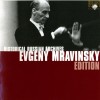
![Russian legends - Emil Gilels [16 CD]](http://static.classicalm.com/repository/collection-cover/small/261-img1318115683212190.jpg)
![Russian legends - David Oistrakh [20 CD]](http://static.classicalm.com/repository/collection-cover/small/267-img1318418713553266.jpg)
![Russian legends - Mstislav Rostropovich [10 CD]](http://static.classicalm.com/repository/collection-cover/small/275-img1319023256353734.jpg)



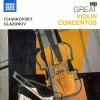










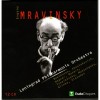









![Rostropovich - Mastercellist [CD1of2]](http://static.classicalm.com/repository/disk-cover/small/3701-img1407155132868814.jpg)









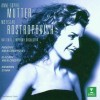



![Sviatoslav Richter - The Beginning of the Legend [4 CD]](http://static.classicalm.com/repository/disk-cover/small/823-img1315991321531276.jpg)



![The Heifetz Collection, Volumes 11 - 15 [5 CD]](http://static.classicalm.com/repository/disk-cover/small/939-img1317071875601277.jpg)
![The Heifetz Collection, Volume 1 [3 CD ]](http://static.classicalm.com/repository/disk-cover/small/715-img1315088819334029.jpg)
![The Heifetz Collection, Volume 2 [3 CD]](http://static.classicalm.com/repository/disk-cover/small/717-img1315129517717299.jpg)
![The Heifetz Collection, Volume 3 [2 CD]](http://static.classicalm.com/repository/disk-cover/small/719-img1315174118757085.jpg)

















